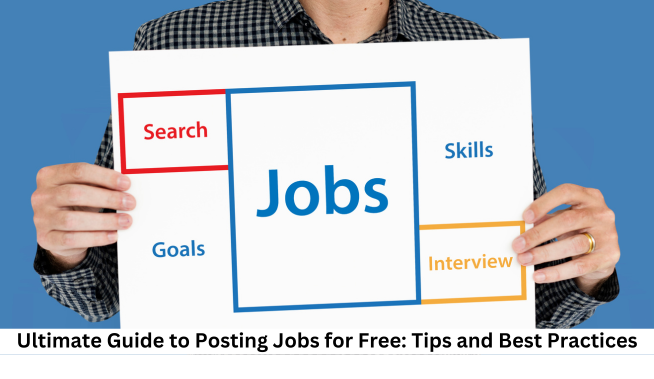

Attracting top talent is crucial for the success and growth of any organization. One of the most powerful tools in this process is crafting compelling job descriptions that grab candidates’ attention and entice them to apply. A well-crafted job description not only provides a clear overview of the role and its responsibilities but also serves as a reflection of the company’s culture and values. It has the potential to make a lasting impression on candidates and influences their decision to apply for a position. In this blog, we will explore the importance of writing engaging job descriptions and provide valuable tips to help you attract top talent to your organization.
Crafting a compelling job description that attracts top talent begins with understanding your target audience. A one-size-fits-all approach simply won’t cut it in today’s competitive job market. By gaining insights into the desired candidate profile, their motivations, aspirations, and values, you can tailor your job description to resonate with them on a deeper level. Understanding your target audience allows you to create a description that speaks directly to their interests, making your job opening stand out among the sea of generic postings. In this section, we will explore the essential steps to understanding your target audience and how to utilize that knowledge to craft job descriptions that captivate and entice the right candidates to apply.
To create a job description that appeals to top talent, it is crucial to conduct thorough research on the desired candidate profile. Start by analyzing the skills, qualifications, and experience required for the role. Look into successful employees who have excelled in similar positions and identify the common attributes they possess. This analysis will provide you with a blueprint for the type of candidate you should target. Additionally, consider the industry trends and advancements that are shaping the job market. Are there any emerging skills or technologies that are highly sought after? Stay updated on the latest industry news and understand the evolving needs and expectations of candidates in your field.
Beyond the technical requirements, it is essential to understand the motivations, aspirations, and values of your target audience. Ask yourself: What drives them? What are their career goals? What kind of work environment and company culture do they desire? Consider conducting surveys or interviews with current employees who are thriving in similar roles to gain insights into what attracted them to the company and what keeps them motivated. This information will help you align the job description with the candidates’ aspirations and values. Moreover, use platforms like social media, professional networks, and industry forums to understand the discussions and conversations happening within your target audience. This will give you valuable insights into their pain points, goals, and the factors they prioritize when considering job opportunities.
Once you have a clear understanding of your target audience, it’s time to tailor the job description to align with their interests. Highlight the aspects of the role that will resonate with them, such as specific projects, challenges, or growth opportunities. Communicate the potential impact they can make and how their skills and experience align with the company’s goals. For example, if your target audience values work-life balance, emphasize any flexible work arrangements, wellness programs, or family-friendly policies your company offers. If candidates are driven by a sense of purpose, emphasize how the role contributes to the company’s mission and the positive impact they can have on society.
Language plays a crucial role in capturing the attention of your target audience. Use words and phrases that resonate with them and reflect their values and aspirations. Avoid jargon or technical terms that may alienate candidates who are not familiar with the industry-specific language. Consider the tone and style of your job description. If your target audience consists of creative professionals, you may adopt a more casual and expressive tone to reflect the company’s culture. Utilize storytelling techniques to create a connection with the candidates. Share success stories of employees who have thrived in similar roles, highlighting their accomplishments and the impact they have made.

The headline of a job description is the first thing that potential candidates will see, and it plays a crucial role in capturing their attention and enticing them to read further. A well-crafted headline sets the tone for the job description and gives candidates a glimpse into the essence of the role. In this section, we will explore various strategies to create attention-grabbing headlines that effectively communicate the key aspects of the position.
When crafting a headline, it’s essential to convey the primary focus and purpose of the job. Candidates should be able to understand the core responsibilities and requirements at a glance. For example, instead of a generic title like “Marketing Manager,” consider a more specific and descriptive headline such as “Innovative Marketing Manager – Driving Growth and Brand Strategy.”
To inject enthusiasm and energy into the job description, choose action-oriented verbs that evoke a sense of dynamism and excitement. These verbs can paint a vivid picture of the role and make it more enticing to potential candidates. For instance, instead of using passive language like “Responsibilities include managing marketing campaigns,” opt for a more engaging approach like “Lead and execute impactful marketing campaigns to drive customer engagement and revenue growth.”
Your headline should also showcase the unique selling points of the position and the company. Consider what sets your organization apart from others and what makes this particular role appealing. Is it the possibility of working with cutting-edge technology, the chance to make a meaningful impact on society, or perhaps the supportive and inclusive company culture? Incorporate these distinguishing factors into the headline to pique candidates’ interest and make them eager to learn more.
In today’s fast-paced world, attention spans are limited, and job seekers often skim through multiple job descriptions. To ensure your headline stands out, keep it concise and impactful. Aim for a headline that can be easily scanned and understood within seconds. Avoid jargon or complex terms that may confuse candidates. Instead, focus on conveying the most important and compelling aspects of the role clearly and concisely.
When it comes to crafting compelling job descriptions, one of the crucial elements is clearly outlining the job responsibilities. Job seekers are looking for clarity and transparency regarding what they will be responsible for if they join a particular organization. By providing a comprehensive overview of the job responsibilities, you not only set realistic expectations for potential candidates but also attract those who possess the necessary skills and experience. In this section, we will delve into the importance of outlining job responsibilities effectively and provide valuable tips to help you achieve this.
To attract top talent, it is essential to provide a comprehensive overview of the job responsibilities in your job description. Candidates want to understand the scope of the role and how it fits into the larger picture of the organization. By clearly outlining the responsibilities, you create a transparent and honest communication channel that allows candidates to assess if they possess the required skills and experience. When providing an overview, be specific and detailed. Instead of using generic statements, break down the responsibilities into specific tasks and duties. This not only helps candidates understand the role better but also allows them to envision themselves performing those tasks, increasing their interest in the position.
When outlining job responsibilities, utilizing bullet points can significantly enhance the readability and clarity of your job description. Bulleted lists help break down the information into easily digestible snippets, allowing candidates to quickly scan and grasp the main points. This format also ensures that essential details are not lost within lengthy paragraphs. Consider structuring the bullet points in a logical order, starting with the most critical tasks and responsibilities. Additionally, use action-oriented language in your bullet points to emphasize the level of accountability and impact associated with each responsibility. This helps candidates understand the significance of the role and how their contributions can make a difference.
While providing a comprehensive overview of the job responsibilities, it’s important to focus on the key tasks and skills required for the role. Highlighting the core responsibilities helps candidates quickly assess if they have the necessary qualifications and experience to excel in the position. Identify the essential skills, competencies, and qualifications that are prerequisites for success in the role. Clearly state these requirements in your job description, ensuring that candidates can determine their suitability at a glance. This saves both the candidates and the hiring team time by attracting those who meet the necessary criteria.
Apart from outlining the regular job responsibilities, it’s crucial to highlight any exciting or challenging aspects of the position. This helps to generate interest and excitement among potential candidates. If the role involves unique projects, opportunities for growth, or the chance to work with cutting-edge technology, be sure to mention it in the job description. By showcasing the more intriguing aspects of the position, you pique the curiosity of candidates and differentiate your job opening from others in the market. It also allows candidates to envision themselves taking on exciting challenges and motivates them to pursue the opportunity further.
The culture and values of a company play a vital role in attracting top talent. Job seekers are not only interested in the specific responsibilities and qualifications of a role but also the overall work environment and the company’s values. By emphasizing the company culture and values in job descriptions, employers can effectively communicate what sets their organization apart and why candidates should be excited to join their team.
One of the key aspects of attracting top talent is showcasing the company’s values, mission, and culture. Candidates want to align themselves with organizations that share their beliefs and have a strong sense of purpose. In the job description, employers can clearly articulate the values and mission of the company, emphasizing the positive impact it has on society or the industry. This helps candidates understand the bigger picture and feel connected to a company that is working towards a shared goal.
Beyond the core responsibilities and compensation, candidates are also interested in the additional perks and benefits offered by a company. These perks can include flexible work arrangements, wellness programs, professional development opportunities, or unique employee benefits. Employers should highlight these perks in the job description to demonstrate that they value their employees’ well-being and are committed to providing a supportive and rewarding work environment.
A strong company vision can serve as a driving force for both the organization and its employees. In the job description, employers should explain the company’s vision and how it positively impacts the employee experience. This helps candidates understand the broader purpose behind their potential role and how their contributions can contribute to the company’s success. By emphasizing the alignment between the company’s vision and the role being advertised, employers can attract candidates who are passionate about the company’s mission.
Candidates seek a work environment where they feel a sense of belonging and where their contributions are valued. In the job description, employers should strive to convey a positive work environment that fosters collaboration, growth, and inclusivity. This can be achieved by highlighting employee testimonials, team-building activities, or any initiatives that promote diversity and equality within the company. Job seekers are not only looking for a job; they are looking for an opportunity to contribute to a company that shares their values and provides a positive work environment. When candidates resonate with a company’s culture and values, they are more likely to be motivated, engaged, and committed employees, leading to long-term success for both the individual and the organization.

When crafting a compelling job description, it’s crucial to showcase the potential for growth within your organization. Job seekers are not only looking for a position that matches their current skills and experience but also one that offers opportunities for career advancement and skill development. By highlighting these growth prospects, you can attract ambitious and motivated candidates who are eager to expand their professional horizons.
One of the key aspects to highlight in your job description is the potential for career advancement. Communicate the pathways for growth within your organization, whether it’s through promotions, cross-functional opportunities, or specialized training programs. This helps candidates envision a long-term future with your company and motivates them to invest their time and energy into the role. Additionally, emphasize the skill development opportunities available to employees. This could include access to training programs, workshops, industry certifications, or mentorship opportunities.
In your job description, be sure to mention any specific training programs, mentorship initiatives, or certifications that your company offers. This could include both formal and informal learning opportunities designed to enhance employees’ skills and expertise. By highlighting these programs, you show potential candidates that you value continuous learning and are invested in their professional development. Alternatively, you could highlight a mentorship program where new hires are paired with experienced employees who can guide and support them in their career journey.
Beyond immediate career advancement and skill development, it’s important to emphasize the long-term benefits of joining your company. This could include opportunities for international assignments, the chance to work on high-profile projects, or the potential to contribute to groundbreaking innovations. Paint a picture of the future possibilities and the impact employees can make by being part of your organization. Furthermore, highlight the benefits package and perks that come with the position. This could include competitive compensation, comprehensive healthcare coverage, retirement plans, flexible work arrangements, or wellness programs. These offerings demonstrate that your company values work-life balance, employee well-being, and overall job satisfaction.
To illustrate the growth opportunities within your organization, consider sharing the success stories of employees who have advanced their careers while working with you. These stories could be featured in the job description or as separate testimonials on your company’s career page. Highlight their professional journey, the skills they acquired, and the impact they made within the company. It helps candidates envision themselves in a similar position, fueling their enthusiasm and motivation to excel in the role. Moreover, it demonstrates your company’s commitment to recognizing and rewarding hard work and dedication.
When it comes to crafting compelling job descriptions, one crucial aspect that should not be overlooked is the tone used in the writing. A job description with a personal and engaging tone can make a significant difference in attracting top talent. It sets the stage for creating a connection with potential candidates, making them feel welcome and excited about the opportunity. In this section, we will explore the various elements involved in utilizing a personal and engaging tone to make job descriptions stand out.
To create an engaging job description, it is essential to communicate in a language that is accessible to a wide range of candidates. Avoid using industry jargon or complex technical terms that may alienate potential applicants who may not be familiar with such language. Instead, opt for clear and straightforward language that everyone can understand. This approach ensures that candidates from diverse backgrounds can easily comprehend the role and its requirements, increasing the likelihood of attracting a broader pool of qualified candidates.
When candidates read a job description, they want to feel like they are having a conversation with someone who genuinely wants them to succeed in the role. Adopting a conversational and friendly tone helps to create this sense of connection. Write the job description as if you are speaking directly to the candidate, using pronouns like “you” and “we.” This approach humanizes the description and makes it more relatable, fostering a positive impression of the company and the role.
Every company has its unique personality, culture, and voice. Integrating these aspects into the job description allows candidates to get a glimpse of what it would be like to work for the organization. Consider the values, mission, and overall brand identity of the company, and infuse those elements into the writing. For example, if the company prides itself on innovation and creativity, let that shine through in the description by using imaginative language and highlighting opportunities for innovative thinking in the role. This way, candidates can better assess if they align with the company’s values and if it would be a good cultural fit for them.
Storytelling is a powerful tool that captures attention and creates an emotional connection. Incorporating storytelling techniques in the job description can help bring the role to life and engage candidates on a deeper level. Rather than simply listing responsibilities and qualifications, paint a vivid picture of what a typical day in the role might look like. Share anecdotes or success stories of current or past employees to illustrate the impact and fulfillment the position can offer. By creating a narrative around the role, candidates can envision themselves in the position and feel inspired to apply. Avoiding jargon, adopting a conversational tone, showcasing the company’s personality, and incorporating storytelling techniques are all key elements in creating engaging job descriptions that attract top talent. Remember, the goal is to make candidates feel excited, welcomed, and compelled to apply, ultimately increasing the chances of finding the perfect fit for the role and the organization.

Once you have crafted a compelling job description that grabs the attention of potential candidates, the next crucial step is to provide clear and concise application instructions. A well-designed application process can significantly impact the number and quality of applicants you receive. By providing step-by-step instructions, specifying required documents, mentioning deadlines, and ensuring a straightforward process, you can streamline the application process and encourage more qualified candidates to apply.
When it comes to applying for a job, candidates appreciate clarity and simplicity. To ensure a smooth application process, it is important to provide step-by-step instructions. Start by clearly outlining how candidates can submit their applications, whether through an online application form, email, or other means. Specify any additional steps they need to take, such as attaching a resume, cover letter, or portfolio. Consider breaking down the application process into simple and actionable steps. Provide guidance on filling out the form, including any required fields or attachments. By offering a clear roadmap, you minimize confusion and ensure that applicants can easily follow through.
To avoid unnecessary back-and-forth communication and to help applicants prepare their materials effectively, it is essential to specify the documents or information required from candidates. Clearly state the necessary attachments, such as resumes, cover letters, portfolios, or references. If there are any specific formats or file types preferred, make that clear as well. If there are any specific questions or prompts that candidates need to address in their application, provide them upfront. This allows candidates to understand the expectations and tailor their responses accordingly. By specifying the required documents and information, you save both the candidates’ and your own time, ensuring a more efficient and organized application process.
When advertising a job opening, it is important to communicate any deadlines or preferred methods of submission. If there is a specific deadline for applications, clearly mention it in the job description. This helps candidates manage their time and prioritize their applications accordingly. Furthermore, if you have a preferred method of submission, whether it is through an online portal, email, or a physical address, make that explicit. By providing this information, you ensure that candidates submit their applications in the preferred manner, making it easier for you to review and process them efficiently.
Complex and convoluted application processes can deter qualified candidates from applying. To attract the best talent, it is crucial to make the application process as straightforward as possible. Avoid asking for excessive information or unnecessary steps that could discourage potential applicants. Review the application process from the candidate’s perspective and identify any areas that may cause confusion or frustration. Streamline the process by removing any unnecessary barriers and reducing the number of required steps. Keep the application form concise and straightforward, asking for only the essential information needed to assess the candidate’s qualifications. Consider providing clear progress indicators or confirmation emails to acknowledge the successful submission of applications.
Job seekers often turn to search engines when looking for employment opportunities. This makes it essential for employers to optimize their job descriptions for search engine optimization (SEO). By incorporating relevant keywords, aligning with industry standards, including crucial details, and making the content easily scannable for search engines, employers can significantly increase the visibility of their job postings and attract a larger pool of qualified candidates.
Keywords play a crucial role in making your job description discoverable by search engines. Conduct research to identify the keywords that candidates are likely to use when searching for similar positions. Include these keywords naturally throughout the description, especially in the job title, qualifications, responsibilities, and skills sections. However, it’s essential to strike a balance and avoid overstuffing the description with keywords, as this can negatively impact readability and user experience.
Employing industry-specific language and terminology not only enhances the accuracy and clarity of your job description but also helps in attracting the right candidates. Job seekers often search for positions using specific industry-related terms. By using appropriate language, you signal to both search engines and potential candidates that your job posting is relevant and credible. Stay updated with current industry trends and incorporate relevant terms to ensure your job description resonates with the target audience.
The job title is a crucial element that job seekers search for when browsing opportunities. It’s essential to have a clear, concise, and specific job title that accurately reflects the position. Incorporate relevant keywords into the job title to improve its searchability. Additionally, ensure that the key skills required for the role are clearly stated in the description. This helps search engines understand the job requirements and ensures that candidates with the right skill sets can easily find your posting.
Prefer to content that is well-structured, organized, and easy to read. To optimize your job description for search engines, make it scannable by using headings, bullet points, and short paragraphs. These formatting elements help search engines crawl and understand the content quickly. Use headings to break down the description into sections, and bullet points to highlight key responsibilities and qualifications. Additionally, consider incorporating schema markup, which provides structured data to search engines, making your job posting more visible in search results.
Crafting compelling job descriptions is essential for attracting top talent. By understanding the target audience, using attention-grabbing headlines, clearly outlining responsibilities, emphasizing company culture and growth opportunities, adopting a personal tone, including clear application instructions, and optimizing for SEO, employers can improve their recruitment efforts. A well-written job description can make a significant impact on candidates’ decision-making process and ultimately attract the best-fit individuals to the organization. To maximize the reach of your job postings, consider utilizing free job posting sites in UAE such as Bayt, Dubizzle, LinkedIn, Indeed, and Naukrigulf. These platforms can help you expand your candidate pool and increase the chances of finding top talent for your organization.
Subscribe & get all related jobs notification
copyright 2025